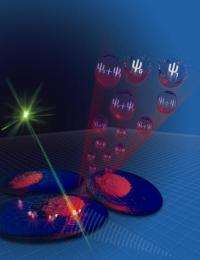Quantum sensor tracked in human cells could aid drug discovery

(�鶹��ԺOrg.com) -- Groundbreaking research has shown a quantum atom has been tracked inside a living human cell and may lead to improvements in the testing and development of new drugs.
Professor Lloyd Hollenberg from the University of Melbourne’s School of �鶹��Ժics who led the research said it is the first time a single atom encased in nanodiamond has been used as a sensor to explore the nanoscale environment inside a living human cell.
“It is exciting to see how the atom experiences the biological environment at the nanoscale,” he said.
“This research paves the way towards a new class of quantum sensors used for biological research into the development of new drugs and nanomedicine.”
The sensor is capable of detecting biological processes at a molecular level, such as the regulation of chemicals in and out of the cell, which is critical in understanding how drugs work.
The paper has been published in the journal Nature Nanotechnology.
Funded by the ARC Centre of Excellence for Quantum Computation and Communication Technology, the research was conducted by a cross-disciplinary team from the University of Melbourne’s �鶹��Ժics, Chemistry, and Chemical and Biomolecular Engineering departments.
The researchers developed state of the art technology to control and manipulate the atom in the nanodiamond before inserting it into the human cells in the lab.
Biologist Dr Yan Yan of the University’s Department of Chemical and Biomolecular Engineering who works in the field of nanomedicine, said the sensor provides critical information about the movement of the nanodiamonds inside the living cell.
“This is important for the new field of nanomedicine where drug delivery is dependant on the uptake of similar sized nanoparticles into the cell.”
Quantum physicist and PhD student Liam McGuinness from the University’s School of �鶹��Ժics said that monitoring the atomic sensor in a living cell was a significant achievement. “Previously, these atomic level quantum measurements could only be achieved under carefully controlled conditions of a physics lab,” he said.
It is hoped in the next few years, that following these proof of principle experiments, the researchers will be able to develop the technology and provide a new set of tools for drug discovery and nanomedicine.
Provided by University of Melbourne



















